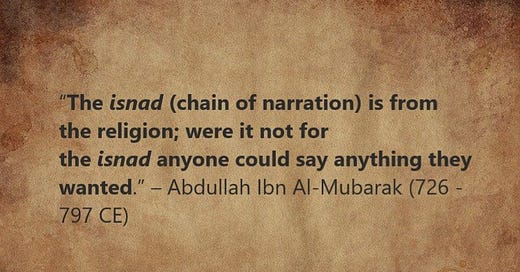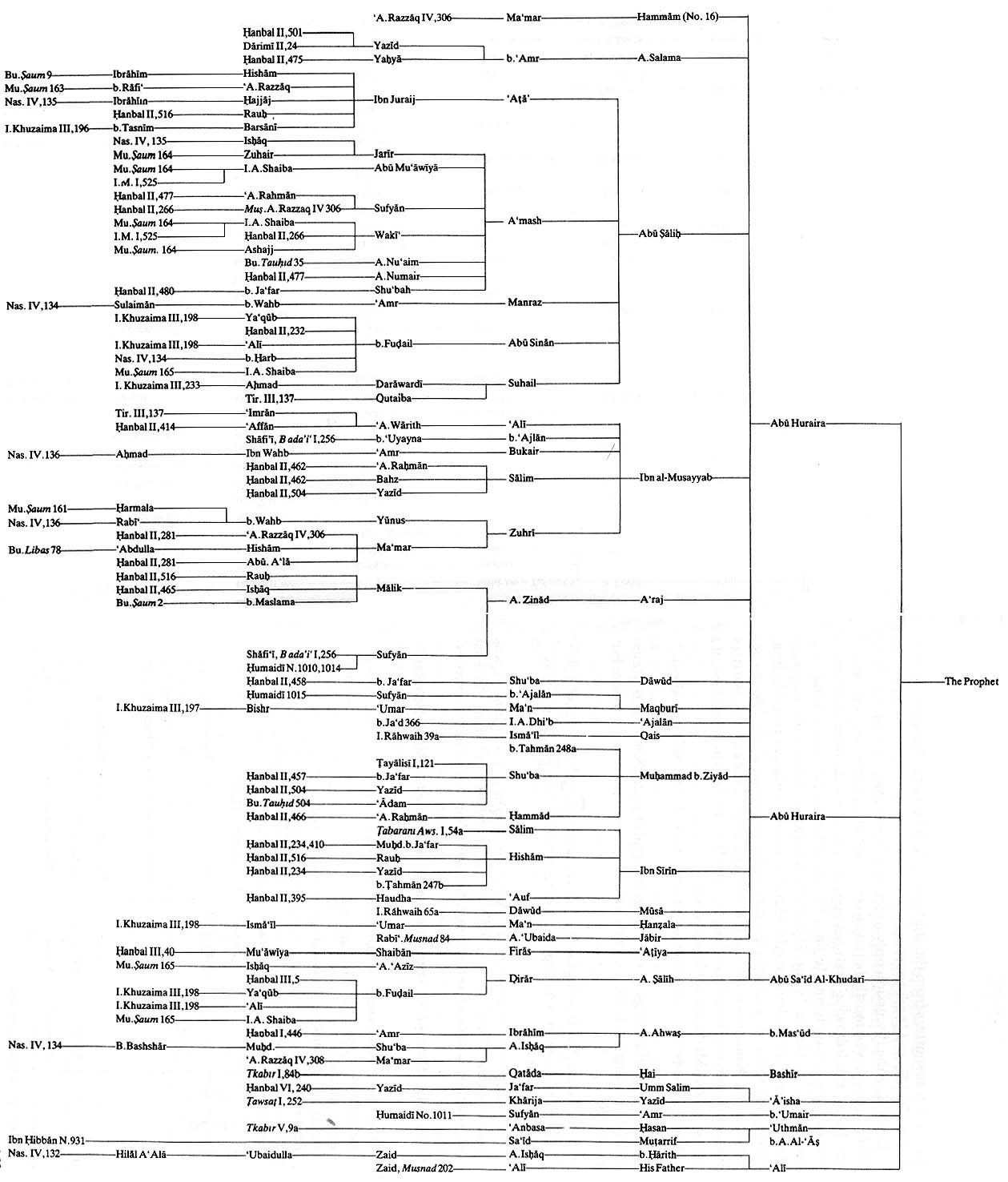In an age of information overload, where misinformation spreads faster than truth, the Islamic tradition offers a timeless lesson in preserving knowledge with integrity. Central to this tradition is the isnād, a rigorous system of verifying the authenticity of the sayings and actions of the Prophet Muhammad (peace be upon him). More than just a historical practice, the isnād remains a living testament to the meticulous care taken to safeguard the teachings of Islam.
In this article, we will explore what the isnād is, how it works, and why it stands as one of the most sophisticated methods of knowledge preservation in human history. As British orientalist and former Church of England priest D.S. Margoliouth once noted in his book Lectures on Arabic Historians:
"The theory of the isnad… its value in making for accuracy cannot be questioned, and the Muslims are justified in taking pride in their science of tradition."
What Is the Isnad?
The isnad (إسناد) is the chain of narrators that connects a hadith (a saying, action, or approval of the Prophet Muhammad) from its original source to the scholars who recorded it. Think of it as a genealogical tree of knowledge, where each link in the chain represents a person who heard and transmitted the hadith. For example:
"A narrated from B, who narrated from C, who narrated from the Prophet Muhammad (pbuh)."
This chain isn’t just a formality it’s the backbone of hadith science (ʿilm al-ḥadīth), a discipline dedicated to verifying the authenticity of the Prophet’s teachings.
here’s an example of how an isnad normally looks
Why Does the Isnad Matter?
The risk of fabrication or error was high in the ancient world as oral traditions were the primary means of transmitting knowledge, Stories could be altered, details forgotten, or outright fabrications introduced, whether intentionally or unintentionally so the isnād emerged as a solution to counter this problem. By meticulously documenting the chain of narrators, early Muslim scholars developed a system that could:
Verify Authenticity – Ensure that a hadith truly originated from the Prophet.
Prevent Fabrication – Weed out false or unreliable narrations.
Preserve Integrity – Maintain the purity of Islamic teachings across generations.
The precision of the isnād system becomes even clearer when compared to other traditions. For example, Christians accept the Gospel of Mark despite there being only one generation between him and Jesus. However, Muslim hadith scholars would reject a narration with such a short chain because they have examined cases where as many as six intermediaries existed between a second-generation narrator and the Prophet (peace be upon him). Their rigorous standards ensured that only the most reliable transmissions were preserved as the reliability of these narrations directly impacted how believers understood and practiced their faith.
Thus, the isnād isn’t just a historical artifact ,it remains one of the most sophisticated systems ever devised for safeguarding truth in a world where misinformation can easily spread.
How Does the Isnad Work?
The evaluation of an isnād is both an art and a science. Hadith scholars meticulously scrutinize each narrator in the chain, asking critical questions:
1. Was the Narrator Trustworthy? (ʿAdl)
A narrator had to be known for their honesty, piety, and moral integrity.
Scholars investigated whether they were known to lie, engage in unethical behavior, or have personal biases that could affect their narrations.
For example: Imam Mālik rejected hadiths from a narrator named Ibn Abī Yahya because, despite his vast knowledge, he was accused of dishonesty in personal dealings.
2. Did They Possess a Strong Memory and Precision in Narration? (Ḍabṭ)
A narrator needed to have an excellent memory or, in later periods, be skilled in accurately recording hadiths in writing.
If a narrator frequently made mistakes or confused names, their narrations would be classified as weak (ḍaʿīf).
Example: Scholars rejected hadiths from Muhammad ibn Isḥāq—despite being a famous historian—because he sometimes narrated hadiths with weak chains and lacked strong precision in transmission.
3. Is the Chain Unbroken, with No Missing Links? (Ittiṣāl)
Each narrator must have directly received the hadith from their teacher, ensuring no gaps in the transmission chain.
If there was uncertainty about whether a narrator actually met their teacher, the hadith would be deemed weak
If a hadith is narrated by someone who claims to have heard it from a scholar, but historical records show they lived in different cities and never met, the narration would be considered disconnected (munqaṭiʿ).
4. Does the Hadith Contradict Established Teachings? (Shudhūdh)
Even if a hadith had a strong chain, it could still be rejected if it contradicted well-known and widely accepted narrations.
Scholars compared hadiths with the Qur'an and other authentic reports to ensure consistency.
Example: A narration stating that "fasting is invalidated by touching a woman" was classified as weak because it contradicted stronger hadiths where the Prophet (peace be upon him) himself touched his wives while fasting.
so Based on these criteria, hadiths are classified into three main categories:
Authentic (Ṣaḥīḥ) – A hadith with a reliable chain of narrators and no anomalies.
Weak (Ḍaʿīf) – A hadith with unreliable narrators or gaps in the chain.
Fabricated (Mawḍūʿ) – A hadith that has been forged or falsely attributed.
These strict criteria ensured that only the most reliable reports were preserved, setting the isnād system apart from other oral traditions. The level of scrutiny applied to narrators was unparalleled in any historical record-keeping system, making hadith science one of the most rigorous methods of knowledge preservation in human history.
The Isnad in Action: A Case Study
To understand the precision of the isnād system, let’s take an example of a chain of narrators from a hadith from Ṣaḥīḥ al-Bukhārī:
"Al-Bukhārī narrated from Muhammad ibn Yusuf, who narrated from Sufyan, who narrated from Abu Ishaq, who narrated from al-Bara' ibn Azib, who narrated from the Prophet Muhammad (peace be upon him)."
You see Each narrator in this chain was meticulously vetted for their trustworthiness and accuracy by Imam al-Bukhārī, who was the compiler of the famous hadith book Ṣaḥīḥ al-Bukhārī, he spent 16 years traveling across the Islamic world, collecting over 600,000 narrations and selecting only about 7,000 for his collection.
One remarkable example of this rigorous verification process is a story my sheikh once told us in class about a muhaddith (hadith scholar) who traveled a great distance to collect a narration from a man known for his knowledge. Upon arrival, he observed the man attempting to lure his camel by pretending to hold food in his hand, despite having nothing. Seeing this act of deception, the scholar immediately refused to take hadith from him, the reason being
"If he can lie to his camel, he can lie about the words of the Prophet (peace be upon him)." He said.
This story illustrates a crucial aspect of isnād authentication: it was not enough for a narrator to have knowledge; their personal character and integrity had to be beyond reproach. Even a minor act of deception could disqualify a person from transmitting hadith.
Such diligence ensured that only the most trustworthy individuals were part of the isnād, preserving the authenticity of the Prophet’s teachings for generations to come.
The Isnād and Modern Challenges
In today’s world, where misinformation spreads at the click of a button, the isnad offers a powerful lesson in critical thinking and verification. It reminds us to:
Question Sources – Just as hadith scholars rigorously scrutinized narrators, we must evaluate the credibility of the information we consume. Before accepting something as true, we should ask:
Who is the source?
Are they reliable and knowledgeable?
Is the information consistent with established facts?
Value Integrity – The isnād system reflects an unwavering commitment to truth. In today’s polarized world, where falsehoods are often spread for personal or political gain, the importance of intellectual honesty cannot be overstated. The scholars of hadith rejected narrators who displayed even minor dishonesty, should we not hold our sources to the same standard?
Preserve Knowledge – The isnād wasn’t just about preserving the past; it serves as a timeless model for safeguarding truth. Whether in academia, journalism, or everyday discussions, ensuring that knowledge is transmitted accurately is a responsibility we all share.
The Legacy of the Isnad As A System for All Eras
The meticulous methodology of the isnād teaches us that truth is not simply about access to information but about verification, reliability, and accountability. If we applied even a fraction of this discipline to modern discourse, the spread of misinformation would be significantly reduced. It reminds us that preserving knowledge isn’t just about recording facts but ensuring that those facts are firmly rooted in truth. Just as hadith scholars dedicated their lives to upholding authenticity, we too must strive to uphold truth in our pursuits whether in academia, journalism, or daily interactions.




